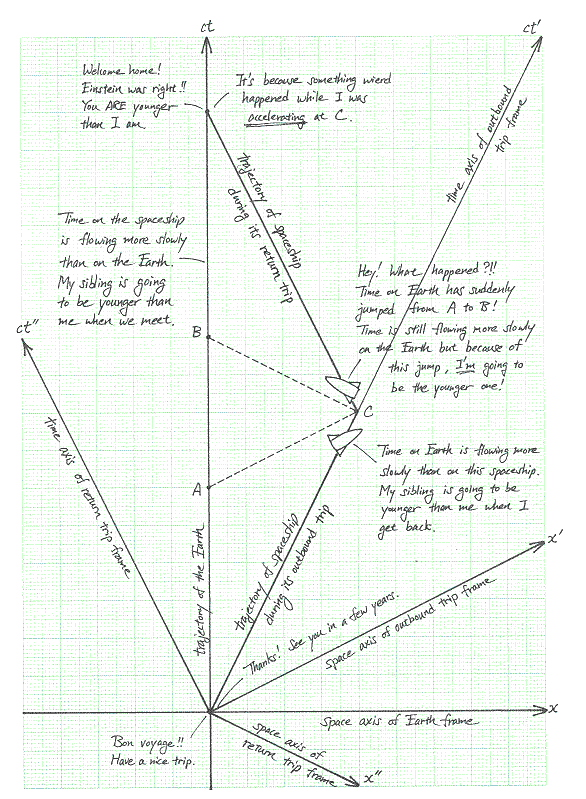

|
College of Science Physics Dept Tatsu Takeuchi Special Relativity Lecture Notes |
 1
2
3
4
5
6
7
8
9
10
11
12
13
14
15
16
17
1
2
3
4
5
6
7
8
9
10
11
12
13
14
15
16
17

15. The Twin ParadoxOne point that might have you puzzled is time dilation: Consider sending an astronaut to a distant star in a spaceship at very hight speed. Assume that the astronaut has a twin sibling waiting back on Earth. In the Earth frame of reference, time on the spaceship will be observed to pass more slowly than on the Earth due to time dilation. It may seem as if only a few years have past on the ship while decades pass on the Earth. So the twin of the astronaut waiting on the Earth expects the astronaut to be the much younger of the two upon return. In the spaceship frame of reference, it is the Earth that is moving at a very high speed so time on Earth will be observed to pass more slowly than on the spaceship. Decades will pass on the ship while only a few years pass on Earth. So the astronaut expects that the twin sibling waiting on the Earth to be the much younger of the two upon return. Isn't this a contradiction? What happens when the astronaut comes back to Earth? Which of the twin siblings will be older? How can both observations be correct? This problem is known as the twin paradox. 
The answer to this question is that for the astronaut to return to the Earth, he/she must change direction and thereby switch from one inertial frame to another, and that breaks the symmetry between the two observers. Now changing direction involves acceleration which puts the astronaut in a non-inertial frame. And as we discussed earlier, special relativity is a theory that only applies to observations made from inertial frames so we can't really tell what the astronaut observes during the acceleration process. But let's for the sake of argument assume that the acceleration process can be made as short as we like and can be considered an instantaneous jump from one inertial frame to another. In the spacetime diagram above, this jump occurs at C. Notice that in the frame the spaceship was in before the jump, C is simultaneous with A on Earth. But in the frame that the spaceship is in after the jump, C is simultaneous with B on Earth. So after the jump, the astronaut discovers that time on Earth has suddenly jumped from A to B. Because of this effect, the astronaut will be younger than his/her sibling when he/she gets back to the Earth.
|